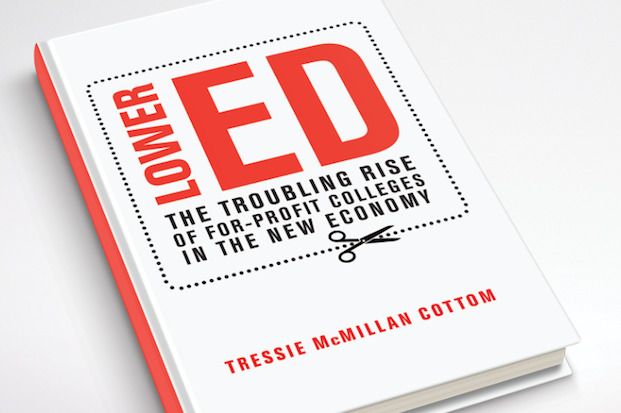Tressie McMillan Cottom’s book Lower ED: The Troubling Rise of For-Profit Colleges in the New Economy, Cottom makes an important intervention on the public perception of the for-profit college. Where many would take up arms against for-profit colleges for exploiting their students by charging more than public universities without real guarantees of a job after graduation, Cottom sees for-profit colleges as arising from a much larger neo-liberal framework that evolved over time. Cottom stresses the importance of this framework for it points to systemic equalities where for-profit colleges should not be seen as a cause, but as a symptom of deeper inequalities falling along lines of race, class, and gender.
Cottom’s willingness to emphasize the systemic inequalities that for-profit colleges arise out of makes sense. Cottom herself used to work as a recruiter for for-profit colleges, and in her book she talks openly about the experience of being a recruiter. Cottom describes the job in the same sort of ways we would expect a sales job to be performed—there are quotas to be met, a scripted pitch they deliver, specific goals at every point of contact, an expected outcome per number of people contacted, etc. For Cottom, this work was incredibly dehumanizing for both her and the students she was expected to recruit, but this alienation also feels key to the deep compassion Cottom has for the people who choose to pursue a degree at for-profit colleges. And it is Cottom’s compassion that makes this book on for-profit colleges stand out.
Cottom clearly sees the students of for-profit colleges as more than just victims preyed upon by these institutions, and pushes her readers to understand these students as savvy, hard-working people. At the same time, Cottom asks us to consider what sort of gatekeeping keeps people from going to a cheaper public colleges. For one, traditional colleges offer little in the way supporting students through the complex enrollment processes, and often care little for fitting the schedules of people who must work and/or raise children while they are going to school. And public colleges are not necessarily interested in changing these things, because they understand their targeted students began their journey to their admissions office long ago as societal and parental expectations of college for them became entrenched. Cottom writes: “traditional colleges invest little time or money in convincing prospective students that college is a valuable proposition.”
For-profit colleges operate on a logic of pushing the value of a degree in order to recruit students traditional colleges rarely care to reach out to. But Cottom also emphasizes the agency of these students through a series of interviews, focus groups, personal narrative, and data collection from documents, studies, and online forums for students enrolled in for-profit colleges. Through her research, Cottom finds that many students at for-profit colleges use the education to leverage their own financial fortunes when needed. One interview pointed to how enrollment in for-profit colleges could lead to student loans withdrawn in order to help pay for other things in the interviewee’s life. Five hundred dollars leftover after tuition was paid could go a long way towards paying for home repairs, new clothes for kids, etc. In this case, students were agents engaged in a “hustle” with their for-profit college, using it in order to secure money while they also secured a degree.
Debt also was not necessarily seen as a bad thing. Cottom’s research pointed to the idea that taking on student loans was a sign of investment and legitimacy. If a school put you in debt, it meant the degree meant something. Cottom describes “Those real degrees, and the debt that came with them, represented the very real sacrifices students had made in earning them. It became a tangible marker of academic rigor.” By elaborating on the way students are seeing their debt, and the way students use student loans, Cottom is advocating for us to also remember that in the for-profit college debates, there is at stake the lives of people as well, the vast majority of which are already facing down the destructive forces of systemic oppression.
Cottom’s final notes end on linking very real political struggles and movements for equality as being answers to the problem of for-profit colleges. Citing #BlackLivesMatter and other activists, Cottom concludes her book by pointing to how the struggles of the students in for-profit colleges will not be solved by somehow making for-profits more ethical or cheaper or better at landing their graduates jobs. Certainly all this would help, but it will not answer for the larger systemic inequalities.
Cottom’s book was published in 2015, but the realities it is challenging are only more pressing now in a conservative administration controlled by Donald Trump; a literal owner of a for-profit college who saw a lawsuit against his college quickly settled when he became the highest government official in the United States. Only more pressing with a woman like Betsy DeVos who, during her hearing for Secretary of Education, openly refused to confirm she would attempt to keep colleges from defrauding students. Some of the people most at risk of exploitation and in need of systemic change are those students targeted by for-profit colleges. Cottom’s book, more than ever, serves as a reminder there are stakes much larger than us academics when it comes to fighting for the sort of progressive change that would truly advocate for the futures of students at for-profit colleges and the institutions beyond them.
